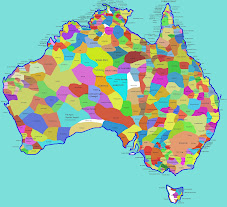
Most linguists now believe that all the native languages of mainland Australia are related, though as contrasted with the Indo-European languages, for example, the concrete evidence for this hypothesis is not nearly so solid. The languages as a group show little to no affinity with the language families in Southeast Asia or Pacific islands. In some areas of Australia a few of the dialects do show some contact with neighboring peoples, specifically along the Arnhem Land coast. There the Yolngu had well established trade relations with Macassan fisherman for several centuries.
There are no written records of any kind surviving from before the advent of European settlement. It is speculated that the Aborigines form a race that is wholly unique and developed over many thousands of years. If that is the case, it would be the merest speculation to suggest that there is any kind of linguistic link to languages outside their native land. As time goes on, archaeologists are establishing earlier and earlier dates for the original Aboriginal settlement and now assert that the first Aborigines settled there even before there was any migration into Indonesia.
When Europeans first began arriving on the Australian continent there were about 300,000 native people living there, by most estimates. The number of languages spoken at that time is not certain, but estimates range anywhere from 150 to 650. The problems that arise when attempting to ascertain the number of languages lie in the fact that there is both a lack of exact information attainable from the past and that the people groups themselves have lived in close proximity for centuries. It is still debated as to whether it is dialects or languages under consideration among the native peoples of Australia.
A conservative estimate of the languages now, given a very wide qualification for dialect variations to be counted as belonging to a single language, would number at about 250. Of these languages, only about 70 are still spoken by 50 people or more. Only 5 languages have in excess of 1000 speakers.
The future for most of these languages is not very secure at this point in time. Many of the native languages are extinct already, with more surely to follow as the older generations die. It is estimated that, due to efforts of state government and other groups such as the Summer Institute of Linguistics (SIL), that about 25 languages have a decently good chance of surviving.
Aboriginal languages are now in use in both governmental and private school and pre-schools in many areas of Australia, though there are none where only Aboriginal languages are spoken. There are many bilingual programs installed which aim to preserve the native language while teaching fluency in English, the aim being to give future generations the tools in which to compete in modern-day Australia.
A Yolngu Matha language course is taught at Northern Territory University. Michael Christie, and Waymamba Gaykamangu, senior lecturer in Yolngu studies, teach Gupapuyngu, one of the Yolngu dialects. They chose Gupapuyngu because most of the educational materials for Yolngu Matha are in this dialect.
In addition, institutes such as the School of Australian Linguistics (SAL) and the Australian Institute of Aboriginal Studies (AIAS) are heavily involved in promoting Aboriginal languages. The SAL itself was established with several united goals in mind: training native speakers so that they could make a career in the study of their own language and contribute not only to linguistics in general but, more specifically, to educational programs for the Aboriginal languages. Many universities now have scholars who are familiar with one or more of the native languages, though courses offered generally concentrate on Aboriginal languages in general rather than a specific language. Charles Darwin University has an excellent site on Yolngu Studies:
http://learnline.cdu.edu.au/yolngustudies/land.htm










